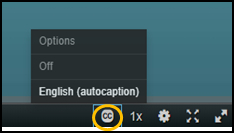Topics Map > Kaltura
Kaltura (Captioning) - Captioning Kaltura Videos
[Note: this article used to contain the following, which have now been spun off into separate articles: Manually Requesting Machine Captions, Editing Captions, and Adding Captions from External Sources.]
Captioning Services
- Automatic machine-generated captions (below)
- Manually requested machine-generated captions
- Professional human-generated captions (This is a paid service, available at participating institutions only.)
- Adding Captions from External Sources
- Editing captions
- Editing the captions label (title) associated with a captions file
- Deleting captions
Automatic Machine-Generated Captions
Beginning December 1, 2021, the UWS DLE Kaltura media management service will automatically add machine-generated captions (auto captions) by default to all new Kaltura videos.
This change is the result of a change request from UW users to turn on Kaltura automatic captioning by default, and has been vetted through a careful process to evaluate and solicit input from a variety of UW System stakeholders. This change does not impact UW-Madison’s Kaltura service.
On 12/01/21 and thereafter, videos created in or uploaded to Kaltura will have machine-generated captions automatically ordered and applied, with no action needed on the part of the video owner. There is no charge to users or campuses for Kaltura auto captioning.
For videos created in or uploaded to Kaltura on or after 12/01/2021, auto captioning replaces the current manual process of ordering captions on a video-by-video basis. For videos added to Kaltura before this date, the video owner or co-editor can manually request that machine-generated captions be added.
About Kaltura Auto Captioning
Kaltura uses automatic speech recognition (ASR) technology to automatically generate captions, a process that converts the audio content of a video into text and displaying the text at the bottom of the video screen. When a video is uploaded, the captioning process begins immediately. Captions are created based on the video’s audio track and the audio content is assumed to be in the English language. The captioning process may take several minutes to several hours to complete, depending on the length of the video.
Captions do not display by default; users watching a video must click the "CC" button in the video player to display captions.

Kaltura uses cookies to remember a video watcher's captions preference, so after a user has clicked the "CC" button to display captions for one Kaltura video, captions on other Kaltura videos will be displayed on that user's machine until the video watcher turns them off.
Accuracy and Editing
Kaltura auto captions are meant for general use and are, on average, approximately 90 percent accurate. Auto caption accuracy varies depending upon the audio quality, clarity of speech, background noise, etc. While video authors are encouraged to edit their video captions to correct errors for accuracy, there is no expectation that correcting auto captions for general use is required.
For more information on editing captions, see the Kaltura (Captioning) - Editing Captions guide.
Auto captioning does not meet the standard for providing a reasonable accommodation, nor does it provide the level of accuracy required for public facing videos — please refer to your campus policies for guidance on caption accuracy requirements. If captions are needed to fulfill a reasonable accommodation for disability-related access, please follow the established process on your campus to ensure your video captions are accurate and meet Americans With Disabilities Act (ADA) requirements.
If the quality of a video’s captions is poor, or if the captions are not needed to fulfill a captioning requirement, the caption file may be deleted from the video.

